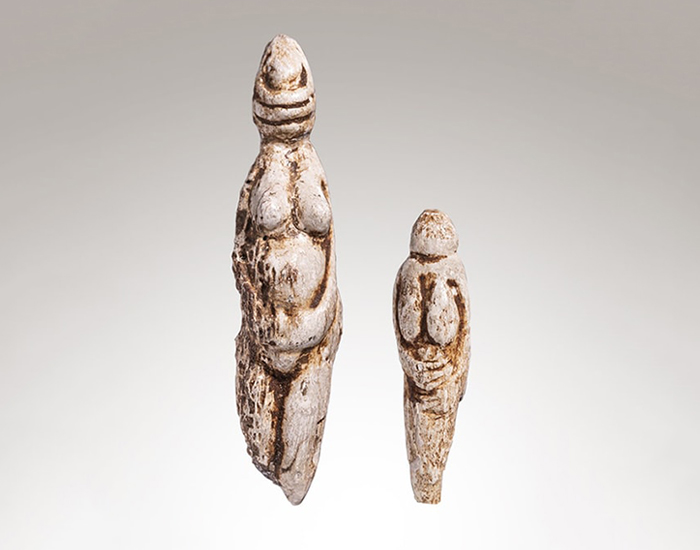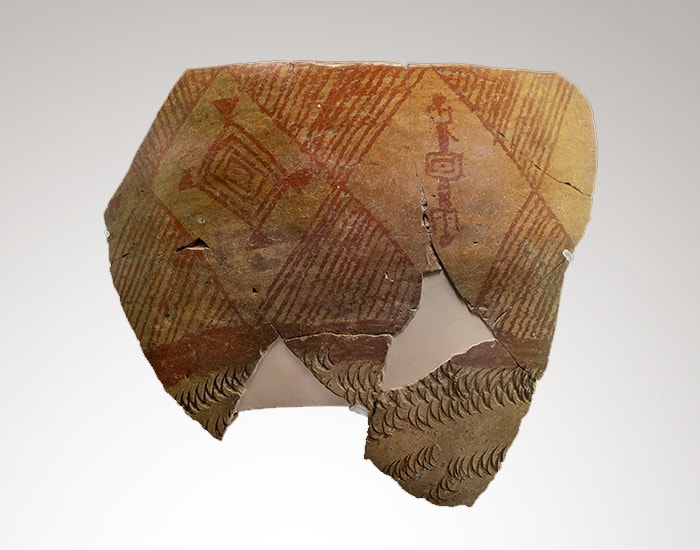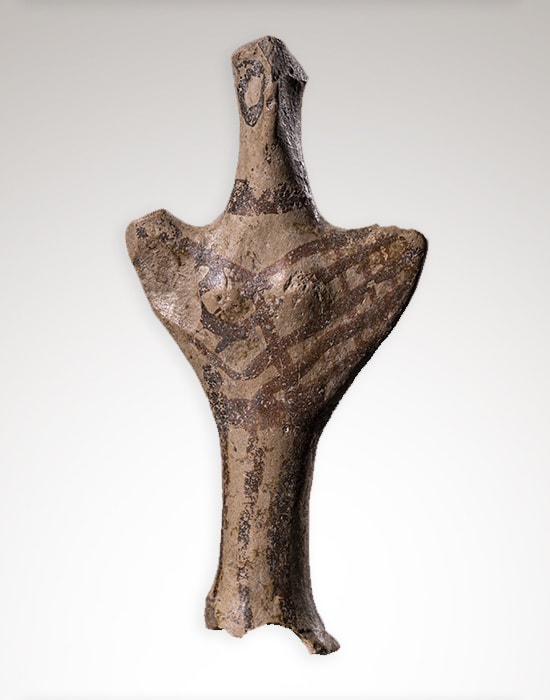Prehistory and Protohistory
ITINERARIES AND COLLECTIONS
The prehistoric section of the MArTA, dedicated to the Superintendent Felice Gino Lo Porto, exhibits a selection of materials representing a timeline that traces the various stages in the development of the Taranto territory from the most ancient settlements until the Bronze Age, revealing the great wealth of the region where archaeological finds have provided items of foremost interest for the study of Italy’s prehistory.
The Palaeolithic Age
(1.6 million years ago - 10,000 years ago)
The archaeological finds of the earliest settlements in this territory belong to the late Palaeolithic Age. They are extremely significant because they bear witness to an extraordinary phenomenon in the history of mankind, namely the development of “art”, whose origins date back to the Prehistoric era. Instances of such finds are the Venuses of Parabita (dated 20,000 years ago) and two pebbles engraved with animal figures from the Romanelli Cave (dated 15,000 years ago).
The Venuses of Parabita, about 18,000 B.C.

The Neolithic Age (6,000-4,000 years ago)
The development of the Neolithic in the Gulf of Taranto was facilitated by extremely favourable environmental conditions. The most ancient items (6000-5300 B.C.) come from the villages along the shores of the Mar Piccolo: ceramic containers for domestic use decorated with impressions, engravings and graffiti, portions of clay plaster from the walls of houses, and tools made out of chipped and polished stone.
The following period (5th-4th millennium B.C.), when there was a considerable growth in the population both on the coast and in the inland areas and when the social structure became more complex, saw the appearance of painted ceramics alongside the items for everyday use. Among these products, the ceramics in the style called “Serra d’Alto” stand out; they are characterized by elaborate geometric decorations and meandering and spiralling motifs and they have elaborate animal-shaped handles. These products are present both in the inhabited areas and in funerary and worship contexts and, due to their stylistic and technological peculiarities, are indicative of the prestige and power of the deceased. The final part of the Neolithic saw the development of a new ceramic style called “Diana-Bellavista”, with simpler decorations and peculiar “spool-like” handles.
Some showcases are dedicated to providing in-depth information about the exchange of raw materials and the symbolic or ideological meanings attributed to some categories of artifacts, to particular decorative motifs or to certain types of context, such as the caves, used during this period both as burial grounds and as places of worship.
Among the materials referable to funerary practices, which during the Neolithic Age progressively became more formal both structurally and in terms of the funerary objects used, a significant discovery were the objects found in the grotto-shaped tomb brought to light in Arnesano. The tomb contained one of the few instances of the little stone “idols” that are well known in Italy.
Ceramic with a painted impressed decoration, 5700-5400 B.C.

The Bronze Age
(2,000-900 B.C.)
During the Bronze Age settlements appeared in Apulia defined as proto-urban settlements, raising often along the coastal areas and on headlands adjacent to natural inlets, with dry-stone walls having a defensive function.
The network of contacts and the trade relations with the Mycenaean world were quite intense and involved various types of goods such as lathed and painted ceramics, glass, ivory, amber and perishable materials of which no trace remains in the archaeological records. The network constituted a strong cultural impulse for the Apulian territory and in particular for the Taranto area. Not too far away, settlements sprang up around naturally protected landing points, among which Scoglio del Tonno, Porto Perone and Torre Castelluccia, which are similar in chronology and stratigraphy and whose development, with ups and downs, can be placed approximately between 1400 and 1200 B.C.
Exchanges with the Aegean world were also an important stimulus for local craftsmanship. One example is Scoglio del Tonno, a “Mycenaean emporium” located to the west of the old city, inhabited from the Neolithic to the Iron Age, and rising in an area that was of key importance for controlling the coast. A large amount of metal objects and traces of metal processing have been found in the excavations of this settlement, as well as abundant local, Mycenaean and Mycenaean imitation ceramics.
Terracotta female Psi figurine of Mycenaean manufacture, 1375-1350 B.C.






